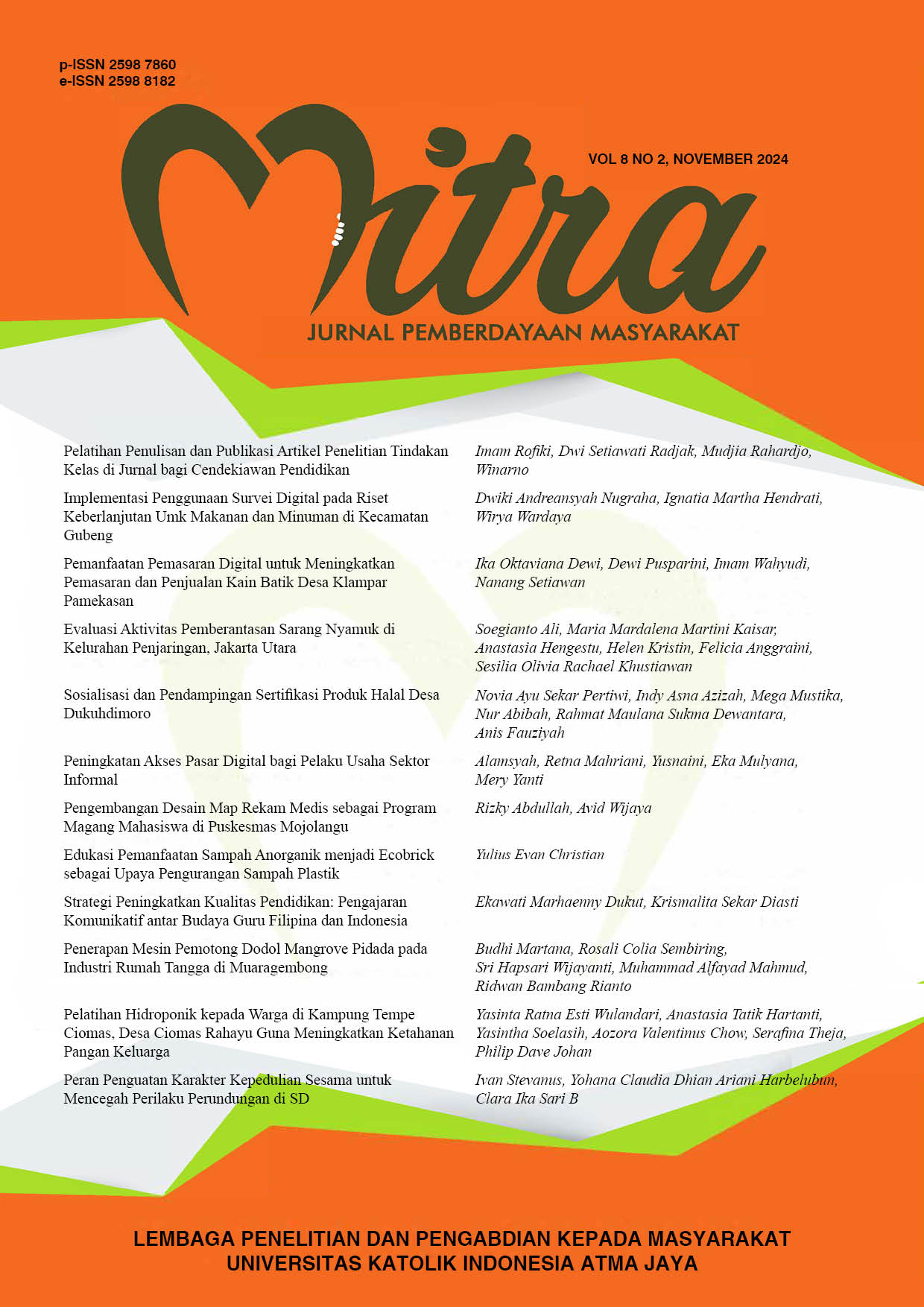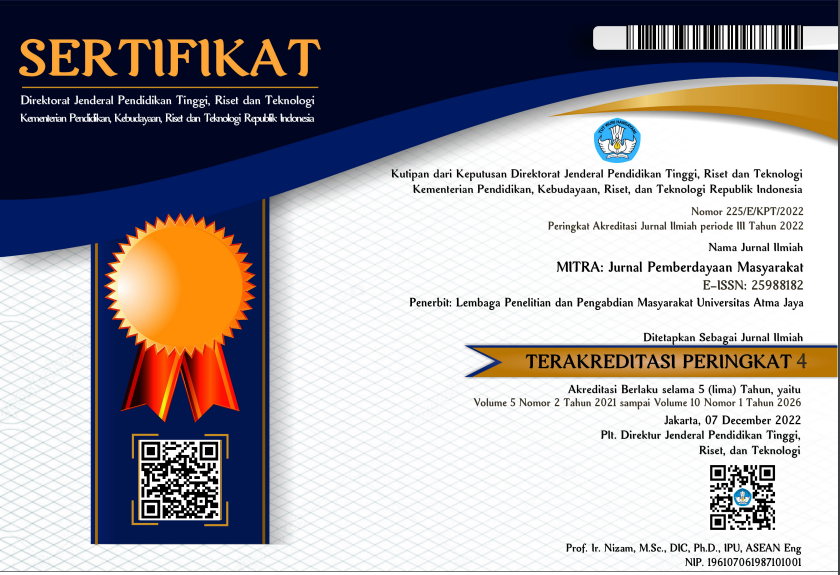Peningkatan Akses Pasar Digital bagi Pelaku Usaha Sektor Informal
DOI:
https://doi.org/10.25170/mitra.v8i2.5390Keywords:
e-commerce, pasar digital, pemasaran, sektor informal, usaha mikroAbstract
This community service aims to intervene the cognitive, effective, and psychomotor aspects of micro and small business actors in utilizing information and communication technology (ICT) as a tool to help their marketing, sales, and business transactions in e-commerce. The target group for service activities is 60 (sixty) villagers who live in three villages (Tanjung Dayang Selatan Village, Tanjung Dayang Utara Village, and Mandi Angin Village) in South Indralaya District, Ogan Ilir Regency, who are eligible and selected purposively. Transfer knowledge and skills using tutorial lectures, discussions, and practicum/simulation methods for two days at the Tanjung Dayang Selatan Village Hall. To maintain the continuity of activities, the service team collaborates with the Tanjung Dayang Selatan Village Youth Organization as a partner in implementing the service. Quantitatively, this project is evaluated by holding a pre-test and post-test which are analyzed using the t-test. Qualitatively, evaluation is carried out through observation and discussion with participants to identify weaknesses and obstacles faced by participants. The community service carried out over the past two days succeeded in increasing community knowledge about the digital market. The increasing of knowledge was statistically robust, t(59) = 29.4030, p < 0.05. Further assistance is needed so that this knowledge can trigger real practices among citizens in utilizing the digital market as a product marketing medium. The service team recommends to policy makers, both at the village and district level, to provide policy support and financial support for economic actors in the digital market.
References
Agyekum, F. K., Reddy, K., Wallace, D., & Wellalage, N. H. (2022). Does technological inclusion promote financial inclusion among SMEs? Evidence from South-East Asian (SEA) countries. Global Finance Journal, 53. https://doi.org/10.1016/j.gfj.2021.100618
Anderson, R., & Ainley, J. (2010). Technology and Learning: Access in Schools Around the World. In P. Peterson, E. Baker, & B. McGaw (Eds.), International Encyclopedia of Education (Third ed., pp. 21-33). Elsevier. https://doi.org/https://doi.org/10.1016/B978-0-08-044894-7.01714-0
Ariansyah, K., Sirait, E. R. E., Nugroho, B. A., & Suryanegara, M. (2021). Drivers of and barriers to e-commerce adoption in Indonesia: Individuals’ perspectives and the implications. Telecommunications Policy, 45(8). https://doi.org/10.1016/j.telpol.2021.102219
Assar, S. (2015). Information and Communications Technology in Education. In J. D. Wright (Ed.), International Encyclopedia of the Social & Behavioral Sciences (Second ed., pp. 66-71). Elsevier. https://doi.org/https://doi.org/10.1016/B978-0-08-097086-8.92104-4
Bank Indonesia. (2023). Pertumbuhan Ekonomi Indonesia Tetap Kuat. Bank Indonesia. Retrieved 14 Mei from https://www.bi.go.id/id/publikasi/ruang-media/news-release/Pages/sp_2511423.aspx
Bidgoli, H. (2003). Electronic Commerce. In H. Bidgoli (Ed.), Encyclopedia of Information Systems (pp. 15-28). Elsevier. https://doi.org/https://doi.org/10.1016/B0-12-227240-4/00049-6
Biro Pers Media dan Informasi Sekretariat Presiden. (2022). Pemerintah Resmi Cabut Kebijakan PPKM Mulai Hari Ini. Biro Pers, Media, dan Informasi Sekretariat Presiden. Retrieved 14 Mei from https://covid19.go.id/artikel/2022/12/30/pemerintah-resmi-cabut-kebijakan-ppkm-mulai-hari-ini
Castells, M., & Hall, P. (1994). Technopoles of the world: The making of twenty-first-century industrial complexes. Routledge Publication.
Chen, L., & Nath, R. (2016). Understanding the underlying factors of Internet addiction across cultures: A comparison study. Electronic Commerce Research and Applications, 17, 38-48. https://doi.org/10.1016/j.elerap.2016.02.003
Curzon, J., Almehmadi, A., & El-Khatib, K. (2019). A survey of privacy enhancing technologies for smart cities. Pervasive and Mobile Computing, 55, 76-95. https://doi.org/10.1016/j.pmcj.2019.03.001
Dinas Perindustrian Perdagangan Koperasi dan Usaha Kecil Menengah Kabupaten Ogan Ilir. (2022). Laporan Kinerja Instansi Pemerintah (LAKIP) Dinas Perindustrian, Perdagangan, Koperasi dan Usaha Mikro, Kecil, Menengah Kabupaten Ogan Ilir Tahun 2021. Dinas Perindustrian Perdagangan Koperasi dan Usaha Kecil Menengah Kabupaten Ogan Ilir.
Dutta, U. P., Gupta, H., & Sengupta, P. P. (2019). ICT and health outcome nexus in 30 selected Asian countries: Fresh evidence from panel data analysis. Technology in Society, 59. https://doi.org/10.1016/j.techsoc.2019.101184
Hadi Putra, P. O., & Santoso, H. B. (2020). Contextual factors and performance impact of e-business use in Indonesian small and medium enterprises (SMEs). Heliyon, 6(3), e03568. https://doi.org/10.1016/j.heliyon.2020.e03568
International Labour Organization. (2023). Informal economy in Indonesia and Timor-Leste. International Labour Organization,. Retrieved 14 Mei from https://www.ilo.org/jakarta/areasofwork/informal-economy/lang--en/index.htm
Iqbal, M., & Suzianti, A. (2021). New Product Development Process Design for Small and Medium Enterprises: A Systematic Literature Review from the Perspective of Open Innovation. Journal of Open Innovation: Technology, Market, and Complexity, 7(2). https://doi.org/10.3390/joitmc7020153
Khan, T., Michalas, A., & Akhunzada, A. (2021). Fake news outbreak 2021: Can we stop the viral spread? Journal of Network and Computer Applications, 190. https://doi.org/10.1016/j.jnca.2021.103112
Kusumaningtyas, N., & Suwarto, D. H. (2015). ICT Adoption, Skill and Use Differences among Small and Medium Enterprises Managers Based on Demographic Factors. Procedia - Social and Behavioral Sciences, 169, 296-302. https://doi.org/10.1016/j.sbspro.2015.01.313
Lestari, D. (2019). Measuring e-commerce adoption behaviour among gen-Z in Jakarta, Indonesia. Economic Analysis and Policy, 64, 103-115. https://doi.org/10.1016/j.eap.2019.08.004
Marsden, C., Meyer, T., & Brown, I. (2020). Platform values and democratic elections: How can the law regulate digital disinformation? Computer Law & Security Review, 36. https://doi.org/10.1016/j.clsr.2019.105373
Mushtaq, R., Gull, A. A., & Usman, M. (2022). ICT adoption, innovation, and SMEs’ access to finance. Telecommunications Policy, 46(3). https://doi.org/10.1016/j.telpol.2021.102275
Nurgroho, J. (2020). As Indonesia faces recession, failure to help informal sector will cost it dearly. South China Morning Post. https://www.scmp.com/week-asia/opinion/article/3098158/indonesia-faces-recession-failure-help-informal-sector-will-cost
Panahi Rizi, M. H., & Hosseini Seno, S. A. (2022). A systematic review of technologies and solutions to improve security and privacy protection of citizens in the smart city. Internet of Things, 20. https://doi.org/10.1016/j.iot.2022.100584
Panayiotou, N. A., & Stavrou, V. P. (2021). Government to business e-services – A systematic literature review. Government Information Quarterly, 38(2). https://doi.org/10.1016/j.giq.2021.101576
Rahayu, R., & Day, J. (2016). E-commerce adoption by SMEs in developing countries: evidence from Indonesia. Eurasian Business Review, 7(1), 25-41. https://doi.org/10.1007/s40821-016-0044-6
Salehan, M., & Negahban, A. (2013). Social networking on smartphones: When mobile phones become addictive. Computers in Human Behavior, 29(6), 2632-2639. https://doi.org/10.1016/j.chb.2013.07.003
Wigand, R. T. (2003). Electronic Commerce. In D. H. Johnston (Ed.), Encyclopedia of International Media and Communications (pp. 489-503). Elsevier. https://doi.org/https://doi.org/10.1016/B0-12-387670-2/00077-7
Yi, Z. (2018). Chapter One—Introduction to Marketing. In Z. Yi (Ed.), Marketing Services and Resources in Information Organizations (pp. 1-17). Chandos Publishing. https://doi.org/https://doi.org/10.1016/B978-0-08-100798-3.00001-5
Zhang, H., Xu, X., & Xiao, J. (2014). Diffusion of e-government: A literature review and directions for future directions. Government Information Quarterly, 31(4), 631-636. https://doi.org/10.1016/j.giq.2013.10.013
Zhang, J., Gong, X., & Zhang, H. (2022). ICT diffusion and health outcome: Effects and transmission channels. Telematics and Informatics, 67. https://doi.org/10.1016/j.tele.2021.101755
Downloads
Published
Issue
Section
License
Copyright (c) 2024 Alamsyah Alamsyah, Mahriani, Yusnaini Yusnaini, Mery Yanti, Eka Mulyana

This work is licensed under a Creative Commons Attribution-NonCommercial-ShareAlike 4.0 International License.
This license allows reusers to distribute, remix, adapt, and build upon the material in any medium or format for noncommercial purposes only, and only so long as attribution is given to the creator. If you remix, adapt, or build upon the material, you must license the modified material under identical terms.







_.jpeg)

.png)
2.png)
.png)
.png)



